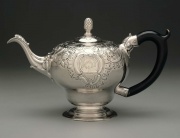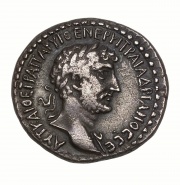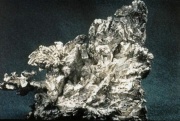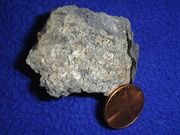Difference between revisions of "Silver"
m (→Description) |
|||
| (6 intermediate revisions by 2 users not shown) | |||
| Line 1: | Line 1: | ||
| − | [[File:35.1775-C42623CR-d1.jpg|thumb| | + | [[File:35.1775-C42623CR-d1.jpg|thumb|Paul Revere teapot<br>MFA Acc. #: 35.1775]] |
== Description == | == Description == | ||
| − | + | [[File:63.93-SC33562.jpg|thumb|Coin of Tarsus<br>MFA Acc. #: 63.93]] | |
A soft, white, ductile metallic element. Silver is widely distributed throughout the world. It occurs rarely as metallic silver (Peru, Norway) but more often as silver-gold alloys ([[electrum]]) and silver ore ([[galena]], cerargyrite, pyrargyrite, [[argentite]]). Today silver is obtained as a byproduct in the refinement of [[gold]], [[lead]], [[copper]], or [[zinc]] ores. The largest current producers of silver are : Peru, Mexico, China, Australia, Russia, Bolivia, Chile, United States, Poland, Kazakhstan. Silver was smelted from galena as early as 3800 BCE. Another early method for refining gold or silver was called cupellation by which the ore was placed in a small cup then exposed to high heat in air; the base metals oxidized while the precious metals melted and were poured off. As a pure metal, silver is second to gold in malleability and ductility. It can be polished to a highly reflective surface. Since pure silver is too soft for many decorative items it is most often prepared as an alloy - [[sterling silver]] (925 parts silver and 75 parts copper). Alloys containing less that 90% silver cannot be stamped as silver. Silver is used for jewelry, coinage, photography, mirrors, electrical contacts, and tableware. | A soft, white, ductile metallic element. Silver is widely distributed throughout the world. It occurs rarely as metallic silver (Peru, Norway) but more often as silver-gold alloys ([[electrum]]) and silver ore ([[galena]], cerargyrite, pyrargyrite, [[argentite]]). Today silver is obtained as a byproduct in the refinement of [[gold]], [[lead]], [[copper]], or [[zinc]] ores. The largest current producers of silver are : Peru, Mexico, China, Australia, Russia, Bolivia, Chile, United States, Poland, Kazakhstan. Silver was smelted from galena as early as 3800 BCE. Another early method for refining gold or silver was called cupellation by which the ore was placed in a small cup then exposed to high heat in air; the base metals oxidized while the precious metals melted and were poured off. As a pure metal, silver is second to gold in malleability and ductility. It can be polished to a highly reflective surface. Since pure silver is too soft for many decorative items it is most often prepared as an alloy - [[sterling silver]] (925 parts silver and 75 parts copper). Alloys containing less that 90% silver cannot be stamped as silver. Silver is used for jewelry, coinage, photography, mirrors, electrical contacts, and tableware. | ||
| − | + | [[File:Silvermetalemr1.jpg|thumb|Native metallic silver]] | |
| − | [[File: | + | [[File:SilverOreemr1.jpg|thumb|Silver ore]] |
| − | |||
== Synonyms and Related Terms == | == Synonyms and Related Terms == | ||
Ag; argentum (Lat.); Zilver (Ned.); argent (Fr.); Silber (Deut.); argento (It.); prata (Port.); plata (Esp.) | Ag; argentum (Lat.); Zilver (Ned.); argent (Fr.); Silber (Deut.); argento (It.); prata (Port.); plata (Esp.) | ||
| + | == Risks == | ||
| − | + | * Inhalation of vapors is toxic. | |
| + | * Noncombustible. | ||
| + | * Fisher Scientific: [https://fscimage.fishersci.com/msds/20770.htm MSDS] | ||
| − | + | == Physical and Chemical Properties == | |
| − | Isometric crystal system. Malleable and ductile. Streak = silver white. Luster = metallic. Tarnish = black, yellow, brown. | + | * Soluble in nitric acid, hot sulfuric acid, alkali cyanide solutions. Insoluble in water, alkalis. |
| − | + | * Attacked by sulfur compounds. | |
| − | [ | + | * Isometric crystal system. |
| + | * Malleable and ductile. | ||
| + | * Streak = silver white. | ||
| + | * Luster = metallic. | ||
| + | * Tarnish = black, yellow, brown. | ||
| + | * [[Potassium%20dichromate|Potassium dichromate]] may be used for the colorimetric detection of silver in objects. It reacts with silver to form bright red silver chromate crystals. | ||
{| class="wikitable" | {| class="wikitable" | ||
| Line 30: | Line 37: | ||
|- | |- | ||
! scope="row"| Melting Point | ! scope="row"| Melting Point | ||
| − | | 960.5 | + | | 960.5 C |
|- | |- | ||
! scope="row"| Density | ! scope="row"| Density | ||
| − | | 10.53 | + | | 10.53 g/ml |
|- | |- | ||
! scope="row"| Molecular Weight | ! scope="row"| Molecular Weight | ||
| Line 39: | Line 46: | ||
|- | |- | ||
! scope="row"| Boiling Point | ! scope="row"| Boiling Point | ||
| − | | 2212 | + | | 2212 C |
|} | |} | ||
| − | + | ==Resources and Citations== | |
| − | == | ||
| − | |||
| − | |||
| − | |||
| − | |||
| − | |||
| − | |||
| − | |||
| − | |||
| − | |||
| − | |||
| − | |||
| − | |||
| − | |||
| − | |||
| − | |||
| − | |||
| − | |||
| + | * O. Untracht, ''Metal Techniques for Craftsmen'', Doubleday and Co., Garden City, NY, 1968. | ||
| + | * Mineralogy Database: [http://www.webmineral.com/data/Silver.shtml Silver] | ||
| + | * Web Elements: [http://www.webelements.com/webelements/elements/text/Ag/key.html Website] | ||
* G.S.Brady, ''Materials Handbook'', McGraw-Hill Book Co., New York, 1971 Comment: p. 723 | * G.S.Brady, ''Materials Handbook'', McGraw-Hill Book Co., New York, 1971 Comment: p. 723 | ||
| − | |||
* Richard S. Lewis, ''Hawley's Condensed Chemical Dictionary'', Van Nostrand Reinhold, New York, 10th ed., 1993 | * Richard S. Lewis, ''Hawley's Condensed Chemical Dictionary'', Van Nostrand Reinhold, New York, 10th ed., 1993 | ||
| − | |||
* ''Van Nostrand's Scientific Encyclopedia'', Douglas M. Considine (ed.), Van Nostrand Reinhold, New York, 1976 | * ''Van Nostrand's Scientific Encyclopedia'', Douglas M. Considine (ed.), Van Nostrand Reinhold, New York, 1976 | ||
| − | |||
* ''The Merck Index'', Martha Windholz (ed.), Merck Research Labs, Rahway NJ, 10th edition, 1983 Comment: entry 8647 | * ''The Merck Index'', Martha Windholz (ed.), Merck Research Labs, Rahway NJ, 10th edition, 1983 Comment: entry 8647 | ||
| − | |||
* ''The American Heritage Dictionary'' or ''Encarta'', via Microsoft Bookshelf 98, Microsoft Corp., 1998 | * ''The American Heritage Dictionary'' or ''Encarta'', via Microsoft Bookshelf 98, Microsoft Corp., 1998 | ||
| − | + | * ''Encyclopedia Britannica'', http://www.britannica.com Comment: silver" [Accessed December 11, 2001]. | |
| − | * ''Encyclopedia Britannica'', http://www.britannica.com Comment: silver" | ||
| − | |||
* C.W.Chesterman, K.E.Lowe, ''Audubon Society Field Guide to North American Rocks and Minerals'', Alfred A. Knopf, New York, 1979 | * C.W.Chesterman, K.E.Lowe, ''Audubon Society Field Guide to North American Rocks and Minerals'', Alfred A. Knopf, New York, 1979 | ||
| − | |||
* David C. Scott, ''Metallography and Microstructure of Ancient and Historic Metals'', The Getty Conservation Institute, Los Angeles, 1991 | * David C. Scott, ''Metallography and Microstructure of Ancient and Historic Metals'', The Getty Conservation Institute, Los Angeles, 1991 | ||
| − | |||
* Susan E. Schur, Conservation Terminology: A review of Past & Current Nomenclature of Materials, ''Technology and Conservation'', Spring (p.34-39); Summer (p.35-38); Fall (p.25-36), 1985 | * Susan E. Schur, Conservation Terminology: A review of Past & Current Nomenclature of Materials, ''Technology and Conservation'', Spring (p.34-39); Summer (p.35-38); Fall (p.25-36), 1985 | ||
| − | |||
* Michael McCann, ''Artist Beware'', Watson-Guptill Publications, New York City, 1979 | * Michael McCann, ''Artist Beware'', Watson-Guptill Publications, New York City, 1979 | ||
| − | |||
* Jack Odgen, ''Jewellery of the Ancient World'', Rizzoli International Publications Inc., New York City, 1982 | * Jack Odgen, ''Jewellery of the Ancient World'', Rizzoli International Publications Inc., New York City, 1982 | ||
| − | |||
* A.Lucas, J.R.Harris, ''Ancient Egyptian Materials and Industries'', Edward Arnold Publishers Ltd., London, 4th edition, 1962 | * A.Lucas, J.R.Harris, ''Ancient Egyptian Materials and Industries'', Edward Arnold Publishers Ltd., London, 4th edition, 1962 | ||
| + | * Wikipedia: [https://en.wikipedia.org/wiki/Silver Silver] Accessed October 2024 | ||
| − | + | [[Category:Materials database]][[Category:MWG]][[Category:Metal]] | |
| − | [[Category:Materials database]] | ||
Latest revision as of 11:08, 3 October 2024
Description
A soft, white, ductile metallic element. Silver is widely distributed throughout the world. It occurs rarely as metallic silver (Peru, Norway) but more often as silver-gold alloys (Electrum) and silver ore (Galena, cerargyrite, pyrargyrite, Argentite). Today silver is obtained as a byproduct in the refinement of Gold, Lead, Copper, or Zinc ores. The largest current producers of silver are : Peru, Mexico, China, Australia, Russia, Bolivia, Chile, United States, Poland, Kazakhstan. Silver was smelted from galena as early as 3800 BCE. Another early method for refining gold or silver was called cupellation by which the ore was placed in a small cup then exposed to high heat in air; the base metals oxidized while the precious metals melted and were poured off. As a pure metal, silver is second to gold in malleability and ductility. It can be polished to a highly reflective surface. Since pure silver is too soft for many decorative items it is most often prepared as an alloy - Sterling silver (925 parts silver and 75 parts copper). Alloys containing less that 90% silver cannot be stamped as silver. Silver is used for jewelry, coinage, photography, mirrors, electrical contacts, and tableware.
Synonyms and Related Terms
Ag; argentum (Lat.); Zilver (Ned.); argent (Fr.); Silber (Deut.); argento (It.); prata (Port.); plata (Esp.)
Risks
- Inhalation of vapors is toxic.
- Noncombustible.
- Fisher Scientific: MSDS
Physical and Chemical Properties
- Soluble in nitric acid, hot sulfuric acid, alkali cyanide solutions. Insoluble in water, alkalis.
- Attacked by sulfur compounds.
- Isometric crystal system.
- Malleable and ductile.
- Streak = silver white.
- Luster = metallic.
- Tarnish = black, yellow, brown.
- Potassium dichromate may be used for the colorimetric detection of silver in objects. It reacts with silver to form bright red silver chromate crystals.
| Composition | Ag (atomic no. 47) |
|---|---|
| CAS | 7440-22-4 |
| Mohs Hardness | 2.5 - 3.0 |
| Melting Point | 960.5 C |
| Density | 10.53 g/ml |
| Molecular Weight | atomic wt = 107.868 |
| Boiling Point | 2212 C |
Resources and Citations
- O. Untracht, Metal Techniques for Craftsmen, Doubleday and Co., Garden City, NY, 1968.
- Mineralogy Database: Silver
- Web Elements: Website
- G.S.Brady, Materials Handbook, McGraw-Hill Book Co., New York, 1971 Comment: p. 723
- Richard S. Lewis, Hawley's Condensed Chemical Dictionary, Van Nostrand Reinhold, New York, 10th ed., 1993
- Van Nostrand's Scientific Encyclopedia, Douglas M. Considine (ed.), Van Nostrand Reinhold, New York, 1976
- The Merck Index, Martha Windholz (ed.), Merck Research Labs, Rahway NJ, 10th edition, 1983 Comment: entry 8647
- The American Heritage Dictionary or Encarta, via Microsoft Bookshelf 98, Microsoft Corp., 1998
- Encyclopedia Britannica, http://www.britannica.com Comment: silver" [Accessed December 11, 2001].
- C.W.Chesterman, K.E.Lowe, Audubon Society Field Guide to North American Rocks and Minerals, Alfred A. Knopf, New York, 1979
- David C. Scott, Metallography and Microstructure of Ancient and Historic Metals, The Getty Conservation Institute, Los Angeles, 1991
- Susan E. Schur, Conservation Terminology: A review of Past & Current Nomenclature of Materials, Technology and Conservation, Spring (p.34-39); Summer (p.35-38); Fall (p.25-36), 1985
- Michael McCann, Artist Beware, Watson-Guptill Publications, New York City, 1979
- Jack Odgen, Jewellery of the Ancient World, Rizzoli International Publications Inc., New York City, 1982
- A.Lucas, J.R.Harris, Ancient Egyptian Materials and Industries, Edward Arnold Publishers Ltd., London, 4th edition, 1962
- Wikipedia: Silver Accessed October 2024



